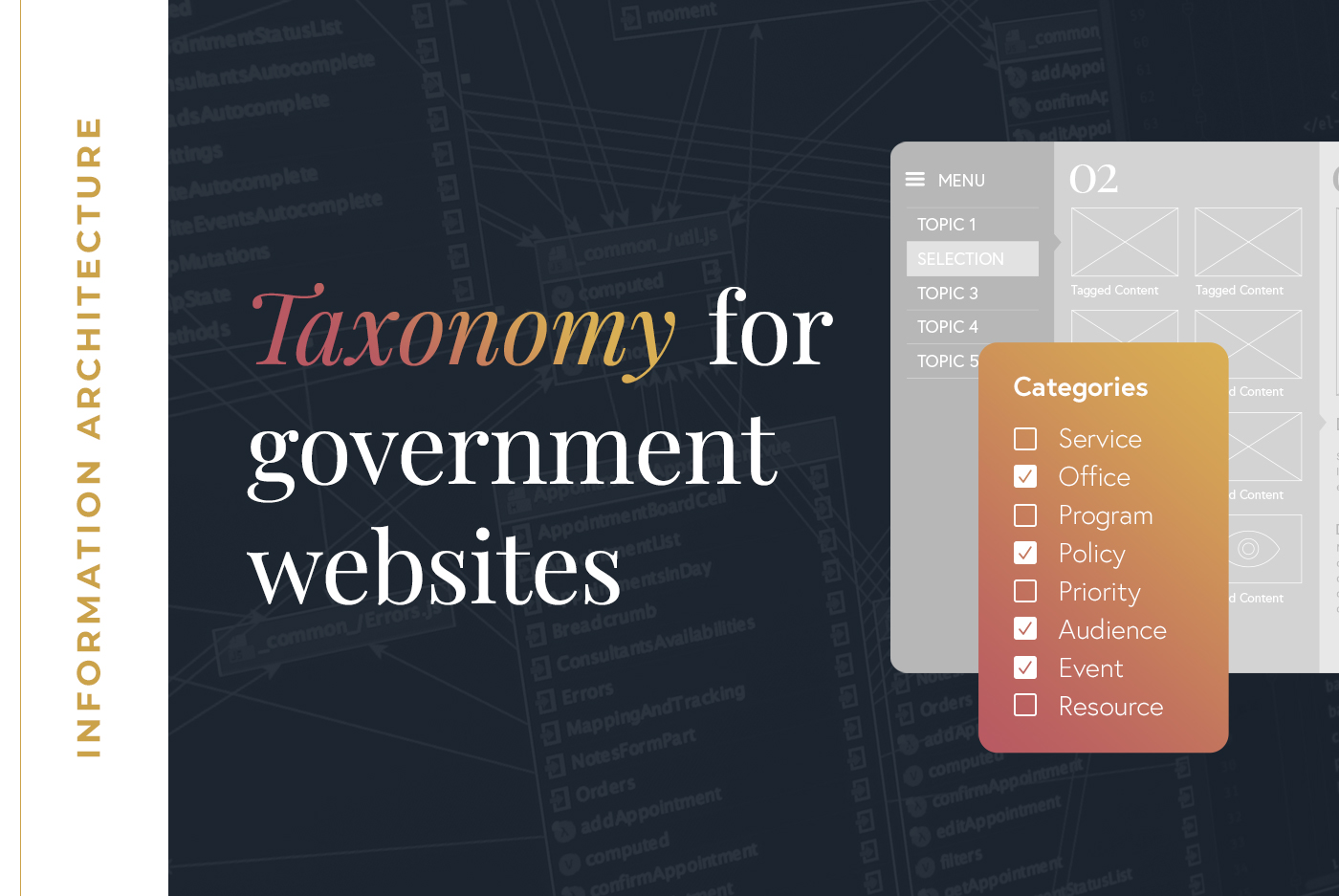Structuring a government website is a unique challenge. Agencies themselves are a blend of traditional hierarchy and matrixed authority. The people they serve are many and varied. And much of their work is highly technical or complex.
Despite these intersecting complexities, an agency website must make its services, programs, and resources easy to find.
Rising to this challenge demands a robust taxonomy.
What is a website taxonomy?
A taxonomy is a set of standardized terms or phrases – also known as a controlled vocabulary – that are used to label (or tag) content on a website. A website taxonomy is actually multiple taxonomies that define key attributes of your content and the relationships between them.
Your site’s taxonomy is an essential component of its overall information architecture and your content strategy. Its purpose is to define relationships between and among pages and other content elements.
Benefits of a robust taxonomy
A well-executed and consistently implemented taxonomy supports bots, human visitors, and content managers.
- For search engines, the site taxonomy drives the URL structure and site map that tells web crawlers how to index your content. Tags identify clusters of related content, sending a strong authority signal to search engines. Even government websites, which tend to have high domain authority scores, need SEO to elevate pages in search results.
- For users, tags make content more findable. They enable on-site search to prioritize content by relevance and allow users to filter and sort search results. Tags also support dynamic generation of related or suggested page links.
- For content managers, tagging can reduce the workload associated with maintaining pages. For example, tags can populate features on the homepage or aggregate related information on a landing page. A well-executed taxonomy also supports content inventories and audits, which can help your team track and prioritize updates.
If you’re sold on the why, here are 5 tips to help develop a robust taxonomy for your agency’s website:
1. Create an audience taxonomy
An audience taxonomy enables you to tag information relevant to specific audiences. Think, types of businesses affected by certain regulations or processes, policies, and opportunities for small business contractors.
This enables you to support self-segmentation right from your homepage or create landing pages customized for one or more key audiences.
2. Prioritize the terms your audience uses
Like everything else on your site, taxonomies should be user-centered.
This means setting aside policy or technical jargon in favor of words and phrases that are familiar to site visitors. For example, your agency may be structured by programs and initiatives, but users come looking for services. Structure and label relevant content as “services” and avoid internally facing terms.
Tip: Your on-site search history holds a wealth of insights on the terms visitors use. You may find that they’re more likely to search by their own problem, challenge, or need rather than the service or policy “solution.”
3. Be careful with acronyms
Government may run on acronyms, but not all audiences can keep up. Even semi-insiders like federal contractors and legislators can get tripped up by an acronym used out of context.
At the same time, acronyms can be useful, shortening unwieldy department or program names and specialized terminology. When your web team is tagging content in your content management system, acronyms may speed up their work.
One solution: Build the internal-facing aspect of your taxonomy with acronyms, but use the full term in displays like search results, filters, and tag clouds.
4. Include your org chart, matrices and all
Your internal agency structure shouldn’t be the basis of your overall information architecture, but there are good reasons to tag content by office, program, etc. – even if that taxonomy would need reworking to keep up with org chart changes.
Aggregating and displaying information along oversight or funding lines, for example, may be useful for some audiences.
Tip: Build your taxonomy to support one-to-many tagging, so you can tag a program with joint ownership to multiple offices.
5. Plan for change
Agency objectives and programs evolve, and your website taxonomy must be able to adapt. When possible, anticipate the need for additional taxonomies, subtopics, or other hierarchical levels, and engineer flexibility in from the beginning. This helps avoid clunky workarounds in the future.
Taxonomy is time well spent
If all this sounds like a lot of work, that’s because it is.
Creating and maintaining a website taxonomy demands strategic AND in-the-weeds thinking. But getting it right will accelerate subsequent phases in the design process.
At Spire, our team excels at helping clients understand the tradeoffs and define taxonomies that meet the needs of site visitors, web crawlers, and content teams.









